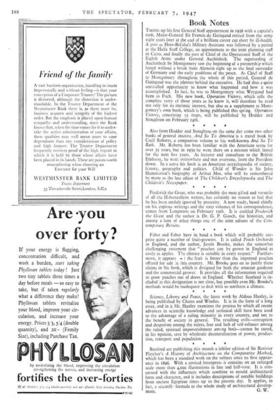Book Notes
TAKING up his first General Staff appointment in 1938 with a captain's rank, Major-General Sir Francis de Guingand retired from the army eight years later at the end of a brilliant career cut short by ill-health. A post as Hore-BeEsha's Military Assistant was followed by a period at the Haifa Staff College, an appointment to the joint planning staff in Cairo, and finally the post of Chief of the Operational Staff of the Eighth Army under General Auchinleck. The superseding of Auchinleck by Montgomery saw the beginning of a partnership which lasted without a break from Alamein right up to the final surrender of Germany and the early problems of the peace. As Chief of Staff to Montgomery throughout the whole of this period, General de Guingand was the planner behind the executive. He had thus a quite unrivalled opportun:ty to know what happened and how it was accomplished. In fact, he was to Montgomery what Weygand had been to Foch. His new book, Operation Victory, which tells the complete story of those years as he knew it, will therefore be read not only for its intrinsic interest, but also as a supplement to Mont- gomery's own book, which is being published this spring. Operation Victory, containing 55 maps, will be published by Hodder and Stoughton on February 24th.
• * * *
Also from Hodder and Stoughton on the same day come two other books of general interest. And So To America is a travel book by Cecil Roberts, a companion volume to his well-known And So To Bath. Mr. Roberts has been familiar with the American scene for over 35 years, but in 1939 he went there on a mission which lasted for the next five years. As lecturer and consultant to the British Embassy, he went everywhere and met everyone, from the President down. In a sense his book is an American encyclopaedia of society, history, geography and politics. Child of Wonder is Sir John Hammerton's biography of Arthur Mee, who will be remembered by many as the late editor of The Children's Encyclopaedia and The Children's Newspaper.
• * * •
Frederick the Great, who was probably the most gifted and versatile of all the Hohenzollern writers, has certainly no reason to feel that he has been unduly ignored by posterity. A new study, based chiefly on his copious writings and the sixty volumes of his correspondence, comes from Longmans on February loth. It is entitled Frederick the Great and the author is Dr. G. P. Gooch, the historian, and among a host of othet things one of the joint editors of the Con- temporary Review.
• * *
Faber and Faber have in hand a hook which will probably sur- prise quite a number of fruit-growers. It is called Peach Orchards in England, and the author, Justin Brooke, makes the somewhat challenging statement that "peaches can be grown in England as easily as apples. The climate is suitable in every respect." Further-
more, it appears t the fruit is better than the imported peaches offered for sale :n this country. Mr. Brooke goes on to justify these claims in his book, which is designed for both the amateur gardener and the commercial grower. It provides all the information required to grow peaches out of doors in England. Whether Scotland is in- cluded in this designation is not clear, but possibly even Mr. Brooke's methods would be inadequate to deal with so northern a climate.
Science, Liberty and Peace, the latest work by Aldous Huxley, is being published by Chatto and Windus. It is in the form of a long essay, and in it Mr. Huxley examines the process by which all recent advances in scientific knowledge and technical skill have been used to the advantage of a ruling minority in every country, and not to the benefit of society in general. The resulting evils—corruption and despotism among the rulers, fear and lack of self-reliance among the. ruled, spiritual impoverishment amcng both—cannot be cured, in his opinion, save by wholesale decentralisation of power, produc- tion, transport and population.
* *
Batsford are publishing this month a jubilee edition of Sir Banister Fletcher's A History of Architecture on the Comparative Method, which has been a standard work on the subject since its first appear- ance in 1896. With a revised letterpress it contains on an enlarged scale more than 4,000 illustrations in line and half-tone. It is con- cerned with the influences which combine to mould architectural form and character, and it includes descriptions of notable buildings from ancient Egyptian times up to the present day. It applies, in fact, a scientifi,' formula to the whole study of architectural develop-


































 Previous page
Previous page